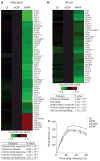Suppression of the antiviral response by an influenza histone mimic
- PMID: 22419161
- PMCID: PMC3598589
- DOI: 10.1038/nature10892
Suppression of the antiviral response by an influenza histone mimic
Abstract
Viral infection is commonly associated with virus-driven hijacking of host proteins. Here we describe a novel mechanism by which influenza virus affects host cells through the interaction of influenza non-structural protein 1 (NS1) with the infected cell epigenome. We show that the NS1 protein of influenza A H3N2 subtype possesses a histone-like sequence (histone mimic) that is used by the virus to target the human PAF1 transcription elongation complex (hPAF1C). We demonstrate that binding of NS1 to hPAF1C depends on the NS1 histone mimic and results in suppression of hPAF1C-mediated transcriptional elongation. Furthermore, human PAF1 has a crucial role in the antiviral response. Loss of hPAF1C binding by NS1 attenuates influenza infection, whereas hPAF1C deficiency reduces antiviral gene expression and renders cells more susceptible to viruses. We propose that the histone mimic in NS1 enables the influenza virus to affect inducible gene expression selectively, thus contributing to suppression of the antiviral response.
Conflict of interest statement
The authors declare competing financial interests: details accompany the full-text HTML version of the paper at
Figures





Comment in
-
Virology: Influenza's tale of tails.Nature. 2012 Mar 14;483(7390):416-7. doi: 10.1038/nature11034. Nature. 2012. PMID: 22419160 No abstract available.
-
Immune evasion: Influenza's sting in the tail.Nat Rev Microbiol. 2012 Apr 11;10(5):312-3. doi: 10.1038/nrmicro2785. Nat Rev Microbiol. 2012. PMID: 22491359 No abstract available.
References
Publication types
MeSH terms
Substances
Grants and funding
LinkOut - more resources
Full Text Sources
Other Literature Sources
Medical
Molecular Biology Databases
Research Materials

